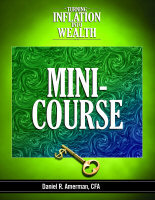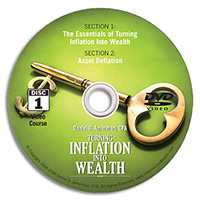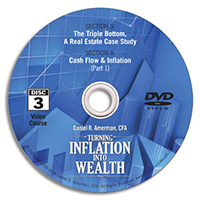Additional Resources
Appendix For Reading Six
The "Deflation" Word
Hopefully, you have found this reading and the five before it to be of interest. Written in 2007, the next sentence in the original reading was: “The risk to you is that one or more of the financial storms currently on the horizon do strike the economy and the dollar, with potentially devastating results for your net worth.” It then went on to talk about whether acquiring an education in the effort to protect your net worth might not be a good risk / return tradeoff.
Much has happened since then. A major financial storm has hit, and it may still just be getting started. Tens of millions of people in the US and around the world have seen the paper value of their retirement portfolios slashed (the key word being “paper”). Slashed again, you might even say, if you include the devastation wreaked on so many conventional portfolios in 2001.
Do the devastating developments of 2008 through 2012 in the real estate market make these materials interesting, but not really relevant? Is it a bit silly to be reading about inflation when the newspaper headlines are about deflation?
This is probably a good place to mention where the mini-course came from. Back in 1999 I became convinced that the number one problem facing retirement investors would be asset deflation in purchasing power terms. I don’t mean deflation in the usual sense, which is price deflation, or the dollar buying more each year. The government can fix that with a symbolic currency, as explained in other readings.
Asset deflation means that your assets buy less each year than they did the year before. When we pierce the illusion of the nominal and look at what our assets will buy for us (which is what matters), we find something else out – monetary inflation (the destruction of the value of your money) and asset deflation in real dollar terms (the destruction of the value of your assets) are not opposing forces, but a natural tag team, working together to devastate the value of savings and investments in distressed economies. How inflation and deflation can work together may initially seem a bit confusing, so we’ll skip the explanation for now, and return later.
If the value of your money is falling, the value of your investment assets are simultaneously falling, and you and the rest of your generation on planning on all liquidating your assets together during retirement, into what could be the greatest buyers market of our lifetimes - then what can you do? Welcome to our new financial world, unfortunately.
Simply put, the conventional financial wisdom not only didn’t predict this – but lacks the tools for how to deal with it. Other than hunker down, stay in that buy and hold, diversified “dartboard” strategy, and forecast that happy days and all our wealth compounding together without limit will return. It’s good to be optimistic, but before you risk what remains of your life savings, do keep in mind that the Japanese have been waiting 20 years, and even with a relatively healthy economy over that time - the Nikkei is still down more than 80%.
After many years of working on this – there are solutions. In fact, I’ve got six books and ten DVDs worth of nonconventional “out of the box” solutions, at this point, with more on the way.
 Level One: Foundation. That would be the free mini-course, which you are currently reading. Over the next few readings we are going to take what we’ve been building, and really put some things together, as we build in true costs after interest payments, uncover sizzling returns in unexpected places, learn about inflation tax shelters, and how to turn government manipulations into arbitrage profits. As the financial crises deepens, conventional investment strategies are devastated, and the US government creates dollars without seeming limitations – these readings are more relevant and necessary than ever. This is the environment they were created in anticipation of, and their intended purpose is to be building blocks. Please note that what you are currently reading is the new version 2 of the mini-course, and the printed book is still currently version one, but the key educational foundation is the same.
Level One: Foundation. That would be the free mini-course, which you are currently reading. Over the next few readings we are going to take what we’ve been building, and really put some things together, as we build in true costs after interest payments, uncover sizzling returns in unexpected places, learn about inflation tax shelters, and how to turn government manipulations into arbitrage profits. As the financial crises deepens, conventional investment strategies are devastated, and the US government creates dollars without seeming limitations – these readings are more relevant and necessary than ever. This is the environment they were created in anticipation of, and their intended purpose is to be building blocks. Please note that what you are currently reading is the new version 2 of the mini-course, and the printed book is still currently version one, but the key educational foundation is the same.
 Level Two: Exploration. How do you apply the theory in the mini-course? That is where the book on the left comes in. The first couple of chapters overlap with this course, but the rest take us to entirely different places. We learn basic hedge fund principles, and how to use mortgages as a hedge to protect not only our net worth, but to help offset risks in other parts of our portfolio, such as our retirement accounts. We study performance under a variety of inflation scenarios, with a variety of time in our residence. We discuss what happens if inflation doesn’t materialize. We talk about risk, and when strategies like this can be a good retirement strategy – as well as the personal situations that can make it a very bad strategy for some other retirees.
Level Two: Exploration. How do you apply the theory in the mini-course? That is where the book on the left comes in. The first couple of chapters overlap with this course, but the rest take us to entirely different places. We learn basic hedge fund principles, and how to use mortgages as a hedge to protect not only our net worth, but to help offset risks in other parts of our portfolio, such as our retirement accounts. We study performance under a variety of inflation scenarios, with a variety of time in our residence. We discuss what happens if inflation doesn’t materialize. We talk about risk, and when strategies like this can be a good retirement strategy – as well as the personal situations that can make it a very bad strategy for some other retirees.
My goal with every page and paragraph of “The Secret Power Within Your Mortgage” was to make it understandable for someone who had never had a finance course in their life. From the letters I get from average people – it worked. There is another kind of letter I get on that book, and that is from financial professionals who recognize the book for what it really is – a reasonably sophisticated primer that accomplishes something unique: teaching the use of hedge fund and institutional asset / liability management techniques in a personal finance and mortgage context. I’m proud of what the book accomplishes – but there is only so much you can do in 200 pages while keeping a book understandable. Which means covering inflation in detail – but only a little bit of asset deflation.
 Level Three: Sophistication. Building in deflation, and particularly building in simultaneous major monetary inflation and major asset deflation, is where things get (analytically) interesting. At the time I started developing these materials, how to invest in an environment where most of the value of the financial markets was being destroyed even as the value of the currency was being shredded, was close to uncharted territory for professional financial analysts. Since I lacked a guidebook, I had to start from scratch, and use my years of professional experience to write some sophisticated and flexible software that I could go exploring with.
Level Three: Sophistication. Building in deflation, and particularly building in simultaneous major monetary inflation and major asset deflation, is where things get (analytically) interesting. At the time I started developing these materials, how to invest in an environment where most of the value of the financial markets was being destroyed even as the value of the currency was being shredded, was close to uncharted territory for professional financial analysts. Since I lacked a guidebook, I had to start from scratch, and use my years of professional experience to write some sophisticated and flexible software that I could go exploring with.
Through running hundreds of simulations of major deflation and inflation scenarios, with thousands of associated yield analyses - I found there were ways of making very good money in those circumstances, on an after-tax and after-inflation basis. But these opportunities were not where you would think they are. Indeed, following a conventional investment strategy from the 90s and early 2000s could very easily lead to the worst performance results, while the points of maximum after-inflation arbitrage would be essentially invisible from a conventional perspective.
 We’ll get back to more on this later, but for now, I will just say that I found two distinct strategies for turning over a 40% decline in the real value of an asset, and a 68% destruction of the value of the dollar, into the equivalent after-tax and after-inflation rate of return that would be achieved by a conventional asset earning over 40%.
We’ll get back to more on this later, but for now, I will just say that I found two distinct strategies for turning over a 40% decline in the real value of an asset, and a 68% destruction of the value of the dollar, into the equivalent after-tax and after-inflation rate of return that would be achieved by a conventional asset earning over 40%.
Counterintuitive strategies, yes, but nonetheless these powerful strategies can handle a wide variety of future inflation and deflation scenarios.
Which left me with a challenge – how to explain these strategies to the people who needed them the most? I didn’t want to write a thousand page tome that would be read only by other analysts.
Level Four. Education. Writing down everything I needed to say about how people could protect themselves in this environment was a daunting task that would have taken years – and I knew that I didn’t have years to work with by that point, the crisis would be there before I was done. But there was an alternative that was even better than writing it down. Get me in front of a group of people and I could talk them through everything they needed to know.
 That was start of the Turning Inflation Into Wealth Workshops. It was only in the workshops that the full body of work was coming together. These workshops were very well received, and I would encourage you to read the testimonials in the brochure. Most importantly – the workshops proved the advanced materials could be reliably taught and understood on a verbal basis, supported by the written materials.
That was start of the Turning Inflation Into Wealth Workshops. It was only in the workshops that the full body of work was coming together. These workshops were very well received, and I would encourage you to read the testimonials in the brochure. Most importantly – the workshops proved the advanced materials could be reliably taught and understood on a verbal basis, supported by the written materials.
Workshop after workshop, I could start explaining on Day One, by Day Two the whole room would be knowledgably talking about inflation and deflation arbitrage points, and by Day Three we would be discussing how to put together dynamic multi-asset strategies that would create tax and cash flow flexibility even while insulating investors from counterparty risks. Then people could go home and apply what they learned to their own specific situations.
The workshops are still the best means of delivering this information. However, with a national audience that has become increasingly international over the years, getting the people who wanted the information in the same city on the same dates was growing problematic. Therefore what is covered in the workshops is also conveniently available in the 8 DVD / 6 Book "Turning Inflation Into Wealth Complete Video Course", more information can be found on the web page linked below. These materials have now been significantly expanded with the addition of the two DVD set, "Gold Out Of The Box".
http://danielamerman.com/aFour.htm









